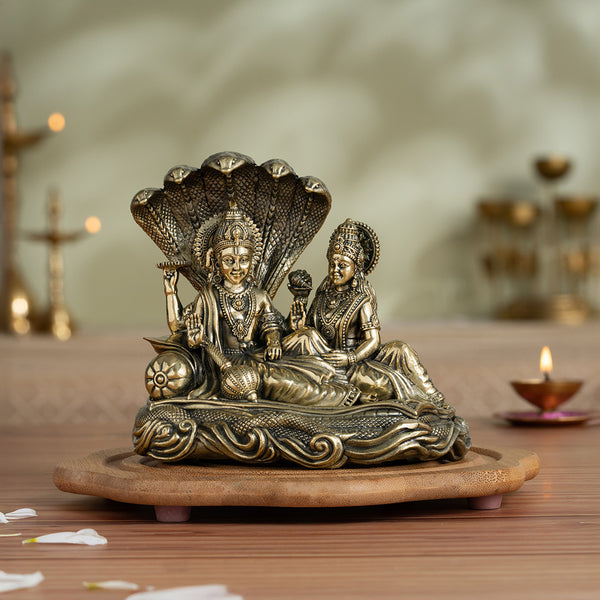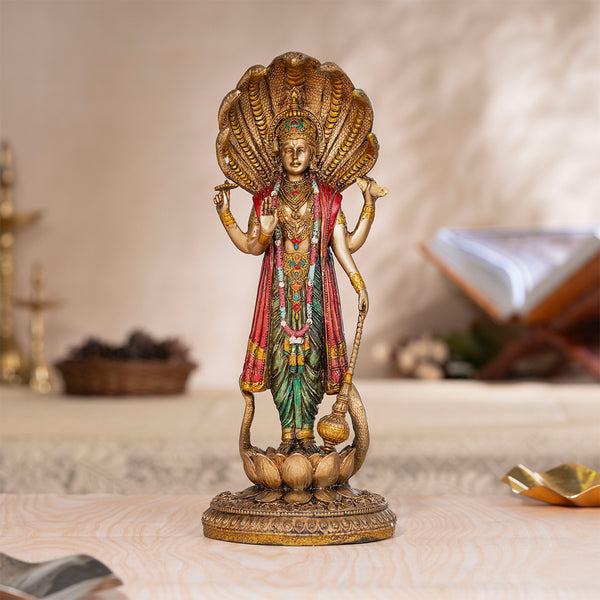In the vast pantheon of Hindu mythology, the tale of Lord Vishnu's avatars is legendary. Known as his ten incarnations, the tenth avatar which is yet to occur, these avatars are believed to be manifested on the earth when in need.
Of the ten avatars, the Vamana avatar, also known as the dwarf incarnation, is one known by all. Appearing as a Vamana, a diminutive divine form, on Earth to restore balance and uphold righteousness.
Lord Vamana, is known for his great wit and quick thinking. Considered a symbol of humility and power, he is still greatly revered for his wisdom and countenance.
Serving as a lesson for how we should not judge things by their appearance, this article will be delving into the Vamana avatar of Vishnu and how Lord Vishnu helped to save the world once again.

Brass Narayana/Vishnu Lakshmi on Ananta-Sajya (5.5 Inch)

Lord Vishnu Standing Antique Idol (12 Inch)
Why Did Lord Vishnu Take The Vamana Avatar?
Vamana avatar is the fifth incarnation of Lord Vishnu. Lord Vishnu's incarnation as a short Brahmin (Brahmin kid Brahmin Brahmachari) is known as Vamana.
Vamana Avatar, or Trivikrama Avatar, was taken by Lord Vishnu to bring balance in the world by defeating the Demon King Bali, an immortal Asura blessed with Amrit and one of the seven Chiranjeevi.
![]()
Because of his newfound power, King Bali was wreaking havoc and upsetting the cosmic balance.
Lord Vishnu, disguised himself and came to King Bali during a sacrifice to save the universe. Lord Vamana had asked for a plot of land three steps in his foot size.
Vamana Avatar Of Lord Vishnu’s Story
Significance Of Vamana Avatar Of Vishnu
As the third of the Holy Trinity who protects the worlds, Lord Vishnu is known to take incarnations on earth whenever the need arises, to defeat evil, restore dharma (righteousness) and establish righteousness.
Vamana Avatar is one such sacred incarnation of the Lord and is regarded as the fifth of his 10 famous incarnations.
This incarnation is believed to have been taken during the Treta Yuga. Vamana refers to the Vamana Avatar (incarnation) of Lord Vishnu, the God of protection and sustenance.
The Sanskrit word ‘Vamana’ is a term used to refer to a ’dwarf,’ and in this Avatar, the Lord appears as a virtual mendicant, who is young and also short in appearance.
The Story Of Lord Vishnu Vamana Avatar

The story of Lord Vishnu’s Vamana avatar is centered around the Asura King, Mahabali. The grandson of Lord Prahaladha, a devout follower of Lord Vishnu, and the son of Virochana.
The story begins with the Gods becoming immortal by consuming the ambrosia taken from the churning of the ocean. The army of Asuras and Daityas were defeated by Lord Indra's army.
This then caused Daityaraj Bali to go seek advice from Shukrcharya Rishi to give him a solution to guide him towards a path that will help Bali get back his powers and his kingdom.
Rishi Shukracharya upon listening to his woes asked him to perform the Mahabhishek Vishwajeet Yagya in order to see what he lost.
King Bali readily agreed to listen to the wise words of his Acharya and proceeded to perform the Yagya under his guidance. Upon its completion, King Bali was presented with a golden chariot that was drawn by horses blessed with the speed of the wind.
Additionally, he was awarded with celestial armour, a flag post bearing a lion’s head, and a quiver of arrows. He was also given a conch that when blown released a thunderous sound and a garland that never withered.
Equipped with his new possessions, King Bali marched into the battleground against Lord Indra. And this time, King Bali emerged victorious.
Thanking his acharya he once again sought his advice on how to retain his fortune. And his guru revealed to him that as long as he continues to perform Yagyas, he can lead a powerful and unconquerable life. He must also help the poor and the Brahmins.
On the other hand, Lord Indra went to Brihaspati Rishi to understand if there is a way for him to overthrow Bali and get his powers back. He was then directed to seek Lord Vishnu.
Lord Indra worshiped Lord Vishu to get his help. Lord Indra’s mother Aditi, Maharishi Kashyas's wife sought out Lord Vishnu to help her son. Lord Vishnu agreed to help Lord Indra and kill Bali.
True to his words, Aditi gave birth to a son and called him Vamana. Lord Vishnu, then incarnated as Vamana disguised himself as a Brahmana and went to the place where the Yagya was being performed by Shukracharya and Daityaraj Bali.
King Bali proceeded to ask the young Brahmin what he wanted. Vamana praised King Bali’s generosity towards Brahmins and the poor and asked him to own the land space covered by three steps of his.
The audience present was taken aback to hear such a request. The asuras howled in laughter at the sheer ridiculousness of the alms demanded by the young boy. Daityaraj Bali agreed to grant the wishes of this young peculiar boy.
Upon agreeing, the young, diminutive form of the young boy, grew in size.
In a matter of time, he was larger than the whole planet. He took one step which covered the whole earth, and the next step blocked the sky which is Amravayo, and he looked at King Bali and asked him where the third step would land.
To his credit, King Bali was determined to uphold his word and said to Vamana, that he may land the third step on his head.
Upon hearing this, Lord Vishnu appeared in his true form and blessed King Bali, and allowed him to rule Pataal Lok.
Thus Bali went away to Pataal Lok. Indra and the other Gods retained Amravati due to Lord Vishnu’s Vamana Avatar.

Conclusion
Brass Standing Lord Vishnu Murti (6 Inch) Brass Tirupati Balaji Lakshmi Divine Diya (5.5 Inch)

The story of the Lord Vishnu Vamana avatar takes place due to King Bali agreeing to the little Brahmana’s request, not realizing that Vamana's size would eventually dwarf the entire universe.
After Vamana's initial two steps, Bali had nowhere to put his third, and he had to back up.
Bali, realizing Vamana's divinity, sacrificed himself by placing his head under Vamana's foot, resulting in the demon's downfall and the restoration of peace and order.
The tale of Vamana Avatar reminds us of the timeless message that greatness lies not in size but in the purity of one's intentions and actions.







